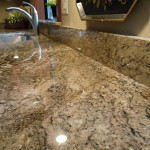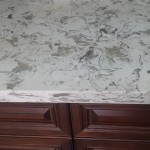Kitchen countertops are hard-working surfaces that more or less act as the kitchen’s ‘workbench’. They present a pretty large surface area and as such give you a large palette on which to influence the decor of your kitchen overall. The key is matching a material and style you like to the kind of lifestyle you live. In other words, good looks are important but don’t make choices at the expense of durability. The best choice is one that will meet your performance expectations, offers great aesthetics and leaves some money in your saving.
Years ago you had only a few choices for countertop surfaces. That’s all changed because today you have a vast array of materials to suit your style and taste. In addition to natural stones such as Granite and Marble, there are many engineered stones (Quartz) which is so popular nowadays. You can find different patterns and colors manufactured by different companies. But before taking a look at the following links, let’s do a little self-assessment on what your expectations are.
- Granite Countertops
- Marble Countertops
- Caesarstone Quartz Countertops
- Hanstone Quartz Countertops
- Silestone Quartz Countertops
Where to Start?
Choosing your countertop can be a fun part of designing your kitchen. But before letting emotion completely take over, write down your goals on what you want to achieve with your new kitchen. This will help you identify specific types that fit your objectives.
Wide range of choices are available, each has their own distinct advantages and disadvantages. Take your time to ask yourself the following questions to help you focus on a short list of options:
- Are you going strictly for a look regardless of any other decision factors?
Giving your kitchen that “wow” factor is certainly an excitement and if that specific countertop is what makes your kitchen pop, then go for it. However don’t think that your countertop will somehow be immune to the stuff that really happens in everyday life and be realistic.
- Are you looking for practicality and something that is easily maintainable and affordable?
A good hard granite (preferably a darker color) is a durable choice and some non-premium colors can be relatively cheap, but it will still be more expensive than laminate. Quartz is another choice which doesn’t need any special maintenance and at the same time with some more affordable patterns.
- How do you want to use your kitchen countertops? Do you do a lot of cooking and food preparation?
Hard-working kitchens (lots of cooking and having kids) need a countertop that will last and still look good after years and years. Look for materials that will last and won’t need so much maintenance. Both granite and quartz are good choices here.
- What kind of long term durability are you looking for? Do you want your kitchen countertop to look the same 10 years from now, with no visible signs of aging, wear or patina?
Some surfaces like metal, wood, and even solid surface will show signs of use over time whether they will change in color or dulling due to scratches. Stone and quartz surfaces will be your best shot at keeping the look over time.
- What level of maintenance are you willing to sign up for?
Some countertops take less effort to maintain than others. Quartz falls into this category. Others, like some natural stones require periodic sealing and upkeep. Be realistic about whether you’re up for the added care or not.
Once you’ve put some thought into these questions, you should be better equipped to sort through the various choices available and narrow down your options. But before you do that here are a few more points to keep in mind before making your decision:
- Some types of stone countertops are naturally porous and will need to be sealed in order to maintain their stain resistance.
- Stone is heavy so your cabinets and supporting structure should be designed to handle the weight.
- Edge treatments play a large role in the overall cost of your countertops. Fancy or intricate edges typically require more time and effort to produce which drives up the cost, particularly with materials that are harder to work and cut like stone. Think about going with a more standard or less elaborate edge. It might allow you to get the countertop of your choice while staying within your budget.
- Engineered countertops can be found in a multitude of different colors and patterns, some that mimic the look of natural stone.
- No material is perfect although some come close from a durability and minimal-maintenance perspective. But don’t think that they’re lasting. So a little care and maintenance is always required.
- Countertop surfaces vary in their strengths and weaknesses so take advantage of that. Don’t be afraid to mix up materials within your kitchen.
Choosing Countertop Materials
As we mentioned before, countertops can be made from a wide range of materials and the cost of the completed countertop can vary widely depending on the material chosen. The durability and ease of use of the material often rises with the increasing cost of the material.
Here we survey two common countertop materials; Natural and Engineered Stones. Take some time to get familiar with them and then take a look at the pros/cons to get a better feel for whether they fit your requirements.
Keep in mind that the choices listed here are primarily categories. Within each category there are various brands and products that are available. For example, there are multiple Quartz surface manufacturers, each with their own design formulas, styles and innovations.
Natural Stone
Granite and marble are categorized in this group. Natural stone has an inherent beauty but there is some maintenance involved in keeping it healthy, depending on the type of stone you buy. Stone countertops are sometimes perceived to be expensive and in some cases this can be true. But there are types of granite that are affordable.
Pros |
Cons |
|
|
Engineered Stone
Engineered stone combines the properties and benefits of real stone (beauty, hardness, durability) with other ingredients to make a product that eliminates some features of stone, which is mainly it’s porosity and maintenance requirements. Quartz countertops make up a large part of the engineered stone category though there are other types of stone that are used. Some of the colors and patterns do a pretty good job mimicking the look of natural stone.
Pros |
Cons |
|
|



